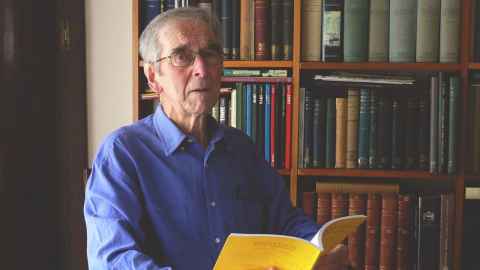Remembering Professor Peter Lowe
29 January 2020
It is with great sadness that we announce the passing of Emeritus Professor Peter Lowe (1934 – 2019).

Peter Gerald Lowe died peacefully on 27 December 2019 in Sydney, where he lived close to his family since 2001 upon retiring from our Department of Civil and Environmental Engineering.
Peter was one of the early graduates from the Ardmore School of Engineering, completing a Bachelor of Engineering in Civil Engineering with 1st Class Honours in 1956. In the same year, he was awarded a research studentship to the University of Sydney, where he completed a Master of Engineering Science. He was then was appointed Honorary Professor of Civil Engineering at the University of Sydney in 2004. There, he continued his academic writing and research on the theory of plates and slabs, adding to his 50 publications in addition to writing five books.
In 1959, he translated V.V. Novozhilov’s Theory of Thin Shells, a reference book for structural engineers, from its original Russian. It's the first text of its kind to appear in English. In the same year, Peter joined Ove Arup and Partners, London, where he was involved in designing multi-story buildings and some early stages of the Sydney Opera House. He then spent four years as an engineering calculation analyst at Ferranti where the early digital computers were built.
He completed his PhD in Mathematics at Birkbeck College, University of London via part-time study in 1963, and subsequently joined the University of Cambridge as a lecturer in engineering and a Fellow of Clare College. He would spend the next 13 years here, where he supervised a number of excellent PhD students. Cambridge University Press published his book, Classical Theory of Structures in 1971. In this book, Peter notably explained that whilst techniques of structural analysis were then based on multiple different methods, it is possible to efficiently solve many problems with one approach based on the differential equation for beam bending.
The University of Strathclyde, Glasgow, was Peter's next move. He was appointed there in 1977 as a Professor of Structural Engineering. In that time, he authored his next book, Basic Principles of Plate Theory (1982). His intent was to present material that wasn't easily accessible to the engineering profession. After his retirement, he expanded this text to Basic Principles of Plates and Slabs (2005).
In 1981, Peter was appointed to a personal chair in Civil Engineering at the University of Auckland, where he also became the Head of Department from 1986 to 1993. Some of his research interests — plate bending mechanics and structural optimisation — were then broadened during his tenure in Auckland to include timber engineering and externally reinforced concrete. The latter was seen as having particular relevance to earthquake damaged structures. He also turned his focus towards sustainability, and studied the recycling of waste materials including the use of paper as aggregate in lightweight concrete.
Engineering heritage was one of Peter’s interests, and he was a founding member and Secretary of the Auckland Chapter from 1980s. For five years, he was Secretary of the National Committee for Engineering Heritage until he moved to Sydney in 2001. He has researched and prepared entries for the Dictionary of New Zealand Biography, describing distinguished engineers that included James Fulton, Samuel Jickell, George Murray, Samuel Crookes, Arnold Downer and Charles Ford. In addition to contributing a number of papers to Australasian heritage conferences, he was also the organiser and editor of the Proceedings of the 2nd Australasian Heritage Conference held in Auckland in February 2000.
The above summary of Peter's career was prepared by Ardmore graduate, John LaRoche. What about Peter the man? Professor Mick Pender from our Department of Civil and Environmental Engineering provided the following testimonial:
"He was of modest disposition and responded to criticism with equanimity.
"He was a thoughtful and gracious colleague. For example, in 1985, he organised a splendid function honouring three professors retiring from the Faculty of Engineering. He led the department in a quiet, kind and fair manner, and was always generous in making allowances for personal circumstances when evaluating staff performance.
"As a teacher, his patience with students was exemplary and he would always advocate for the students when changes to university procedures and regulations were under consideration.
"He was a deep thinker and came up with many interesting and novel ideas. His independence of mind meant that he was happy not to be following current fashionable research topics. He also pondered deeply the current state of the engineering profession and what the future held.
"Further to his interest in engineering heritage, he had a significant personal library containing many books on early science and engineering, and many on topics of relevance to New Zealand, where books about Cook and Scott were apparent. He was proud of the fact that he needed 100m of shelving, which he constructed himself, to accommodate this collection."